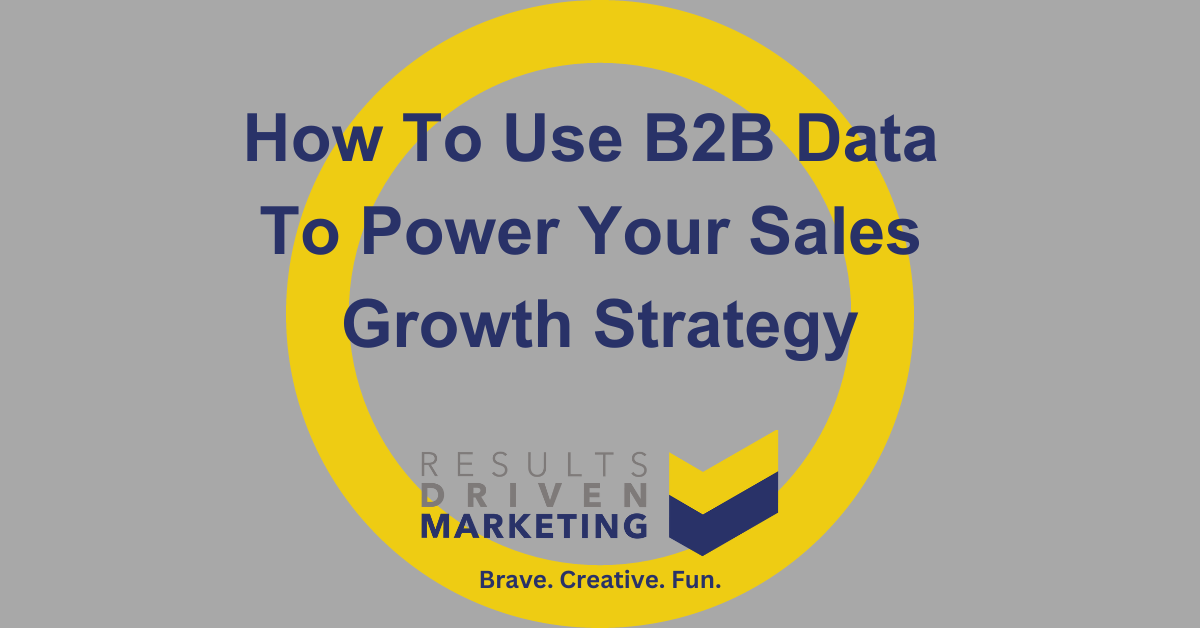
How To Use B2B Data To Power Your Sales Growth Strategy
Sales growth is the primary goal for many businesses aiming to expand and thrive in competitive markets.
This article explores the various strategies and factors that can fuel this essential aspect of business success.
From innovative marketing tactics and customer engagement to operational efficiencies and market expansion, we’ll provide a comprehensive look at how companies can achieve and sustain robust sales growth.
Whether you’re a startup looking to make your mark or an established entity seeking new growth avenues, understanding these principles is key to propelling your business forward.
What is a Sales Growth Strategy?
A sales growth strategy is a planned approach designed to increase the volume of sales or revenue for a business or product. It outlines the steps, tactics, and methodologies a company will use to expand its customer base, enter new markets, and achieve a larger share of the market. The strategy is often developed based on insights derived from market research, sales data, and other relevant information.
Key components of a sales growth strategy include:
- Target Market Identification: Understanding and defining the specific audience or segment the business aims to serve. This involves demographic, geographic, and psychographic profiling.
- Product or Service Expansion: Introducing new products or services, or enhancing existing ones to cater to a broader audience or to meet changing market demands.
- Pricing Strategies: Adjusting pricing models to attract new customers, retain existing ones, or penetrate new markets. This could involve discounts, bundling, or premium pricing strategies.
- Sales Channel Expansion: Utilising multiple channels to reach customers, such as online platforms, retail outlets, direct sales, or partnerships.
- Promotional and Marketing Efforts: Implementing advertising campaigns, content marketing, social media marketing, and other promotional activities to create awareness and drive demand.
- Customer Relationship Management (CRM): Using CRM tools to manage and analyze customer interactions throughout the customer lifecycle, aiming to improve business relationships, retain customers, and drive sales growth.
- Sales Training and Development: Equipping the sales team with the necessary skills, knowledge, and tools to effectively sell the product or service.
- Market Penetration: Increasing market share in an existing market, often by offering promotions, lowering prices, or launching aggressive marketing campaigns.
- Market Development: Entering new markets or targeting new segments within existing markets.
- Diversification: Adding new products or services that may or may not be related to the current business offerings.
- Partnerships and Collaborations: Forming strategic alliances with other businesses to co-promote, distribute, or produce products or services.
- Feedback and Continuous Improvement: Regularly collecting feedback from customers and the sales team to refine and improve the sales strategy.
In essence, a sales growth strategy is a roadmap that guides a business in its efforts to increase sales, whether by acquiring new customers, selling more to existing customers, or expanding into new markets.
How to Create a Sales Growth Strategy For Your Business
Creating a sales growth strategy for your business involves a systematic approach to understanding your market, setting clear objectives, and implementing actionable steps to achieve those objectives. Here’s a step-by-step guide to help you craft an effective sales growth strategy:
- Understand Your Current Position:
- SWOT Analysis: Begin by analysing your business’s Strengths, Weaknesses, Opportunities, and Threats.
- Sales Audit: Review your current sales figures, customer retention rates, and the effectiveness of past strategies.
- Define Your Target Audience:
- Market Segmentation: Break down your market into smaller segments based on demographics, geographics, psychographics, and behaviour.
- Customer Profiling: Understand the needs, preferences, and pain points of your ideal customers.
- Set Clear Objectives:
- Determine what you want to achieve, whether it’s a specific increase in sales numbers, market share, or customer base expansion.
- Ensure your objectives are SMART (Specific, Measurable, Achievable, Relevant, Time-bound).
- Develop Your Unique Selling Proposition (USP):
- Identify what sets your product or service apart from competitors.
- Craft a compelling message that communicates the unique benefits of your offering.
- Choose Sales Channels:
- Decide whether to focus on direct sales, online sales, retail outlets, partnerships, or a combination.
- Consider emerging channels or platforms that align with your target audience’s behavior.
- Implement Pricing and Promotional Strategies:
- Adjust pricing based on market demand, competitor pricing, and perceived value.
- Plan promotions, discounts, or bundles to incentivize purchases.
- Enhance Customer Relationship Management (CRM):
- Invest in CRM tools to track and manage customer interactions.
- Use data analytics to gain insights into customer behavior and preferences.
- Train and Equip Your Sales Team:
- Provide regular training sessions on product knowledge, sales techniques, and market trends.
- Equip them with the necessary tools and resources to close deals effectively.
- Expand to New Markets or Segments:
- Research potential markets or segments that align with your product or service.
- Test the waters with pilot campaigns before fully diving in.
- Leverage Digital Marketing:
- Optimise your website for conversions.
- Engage in content marketing, SEO, PPC advertising, and social media marketing to reach a wider audience.
- Monitor, Measure, and Adjust:
- Regularly track the performance of your sales strategy using key performance indicators (KPIs).
- Adjust your tactics based on feedback, market changes, and the results of your efforts.
- Seek Feedback and Continuously Improve:
- Encourage customer feedback through surveys, reviews, and direct interactions.
- Use this feedback to refine your product, service, and overall sales strategy.
- Stay Updated with Market Trends:
- Attend industry conferences, workshops, and webinars.
- Regularly research and analyse market trends, competitor activities, and technological advancements.
By following these steps and maintaining a proactive approach, you can craft a sales growth strategy that not only aligns with your business goals but also resonates with your target audience. Remember, a successful strategy is dynamic and evolves with changing market conditions and business needs.
Understanding B2B Data
First off, what is B2B data? It’s information about businesses that cater to other businesses. Think of it as the behind-the-scenes chatter that companies share. This could be anything from industry reports to juicy tidbits from trade shows. And here’s a fun fact: B2B data is different from B2C data. While B2C focuses on individual consumers, B2B zeroes in on businesses. It’s like comparing apples to office buildings—both valuable but in different arenas.
The Importance of Quality Data
Imagine trying to bake a cake with expired ingredients. Not appetising, right? The same goes for using outdated or inaccurate data. Quality data is the backbone of sales growth. With top-notch data, you’re setting yourself up for success. But with poor data? You might as well be throwing darts in the dark. So, always ensure your data is fresh, accurate, and ready for action!
How to Utilise B2B Data in Sales (The Fun Part!)
- Segmentation and Personalisation:
Ever received an email that felt like it was written just for you? That’s the magic of data-driven personalisation. By segmenting potential clients based on B2B data, you can craft pitches that resonate, making your sales growth soar. - Predictive Analysis:
Got a crystal ball? No? Well, B2B data is the next best thing. Dive into historical data, and you can predict future sales trends. It’s like having a sneak peek into the future of your sales growth. - Sales Funnel Optimisation:
Picture your sales process as a funnel. Now, imagine using B2B data to smooth out any bumps or blockages. The result? A streamlined process where prospects glide effortlessly from awareness to purchase, boosting your sales growth. - Competitive Analysis:
Want to know what your competitors are up to? B2B data has got your back. By gaining insights into their strategies, you can find gaps in the market and position yourself uniquely, driving your sales growth even further.
Integrating B2B Data with Sales Tools
Remember those cool gadgets James Bond always had? In the world of sales growth, CRM systems and data analytics tools are your gadgets. By integrating B2B data with these tools, you get real-time insights, making your sales strategy sharper and more effective.
Ethical Considerations and Data Privacy
While B2B data is super powerful, it’s essential to play by the rules. Always respect data protection regulations like GDPR. Think of it as the superhero code for data. By ensuring ethical data practices, you build trust, which is priceless for sales growth.
Conclusion
As we’ve journeyed through the intricacies of leveraging B2B data, it’s evident that when utilised strategically, it becomes the linchpin for driving sales growth.
Businesses that embrace this data-driven approach position themselves at the forefront, turning insights into actionable strategies that yield tangible results.
As you move forward, remember that the fusion of quality B2B data with a well-crafted sales strategy is the formula for sustainable growth.
Armed with this knowledge, you’re poised to elevate your sales game and set new benchmarks for success. Here’s to unlocking unparalleled sales growth with the power of B2B data!
Contact us for more information on how our data can help power your growth strategies





